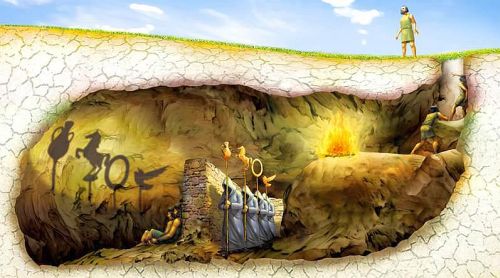“The Allegory of the Cave, 1984 and The Matrix contain corresponding layers. Each explores a diabolical form of societal control; the control of thought through the presentation of selective information and images, in combination with physical constraints of strict surveillance and imprisonment” ~ E. I. Smith
 Some philosophical work is so profound as to be influential for thousands of years. Plato’s ‘The Republic‘ is one such series of dialogues. It explains and explores the relationship between state institutions and individuals, and has provided humanity with lessons in politics, philosophy and individual enlightenment since it was penned some two thousand years ago.
Some philosophical work is so profound as to be influential for thousands of years. Plato’s ‘The Republic‘ is one such series of dialogues. It explains and explores the relationship between state institutions and individuals, and has provided humanity with lessons in politics, philosophy and individual enlightenment since it was penned some two thousand years ago.
One of the central dialogues in The Republic is called the Allegory of the Cave. The lessons the Allegory of the Cave provides to today’s world are numerous, and its depiction of our insidious societal structure is extremely accurate and insightful — despite often going unacknowledged as such. Through its exploration of our political outer states, it also explores our psychological inner state as well.
The Allegory of The Cave proposes that what people take to be ‘reality’ in total is only a partial reality, or an all out illusion. As is all similar philosophy, the allegory is layered, but it is partially about breaking from mainstream thinking and seeking individual knowledge; the ascension of perspective; being in a cave and coming out of a cave. It’s about how we can ascend from the bottom to stand face-to-face with the golden Sun.
Socrates begins: “Let me show you in a figure how far our nature is enlightened or unenlightened Behold! Human beings living in an underground cave”.
The 4 Characters of the Cave
In the Allegory there are four character types. Most people are chained, forced to watch images on a cave wall. Some however, the second character type, are unchained. They need no force; they are so transfixed with the imagery on the wall that the shadows are all they care about, and remain in the cave by choice. The images are cast on the wall by the third character type, the captors, who use a fire behind them to produce various shadows, to keep the prisoners entertained. The prisoners interpret the shadows and whatever noises are made as reality in total, for it is all they know. The fourth character type is the freed prisoner. Continue reading →
Socrates: Imagine people are kept in an underground cave from childhood, their legs and necks in chains so that they can see only in front of them. There is a fire behind them casting shadows on the back wall of the cave. Between the prisoners and the fire there is a road along which “puppet-masters” carry objects that cast shadows on the back wall of the cave. Some of the puppet-masters speak, others are silent.

 Some philosophical work is so profound as to be influential for thousands of years. Plato’s ‘The Republic‘ is one such series of dialogues. It explains and explores the relationship between state institutions and individuals, and has provided humanity with lessons in politics, philosophy and individual enlightenment since it was penned some two thousand years ago.
Some philosophical work is so profound as to be influential for thousands of years. Plato’s ‘The Republic‘ is one such series of dialogues. It explains and explores the relationship between state institutions and individuals, and has provided humanity with lessons in politics, philosophy and individual enlightenment since it was penned some two thousand years ago.